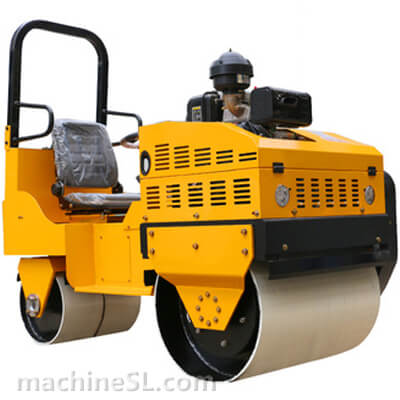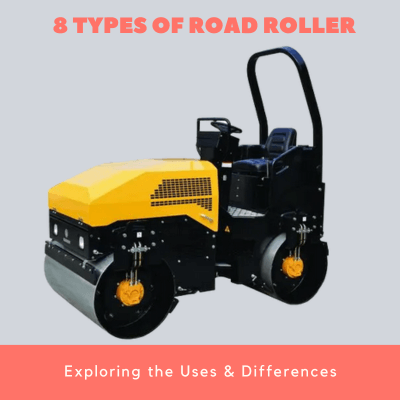How to use Road Roller Like a Pro:A Step-by-Step Guide
One of the main characteristics of the modern-day construction industry is mechanization. A lot of procedures and process initially done by human power are now done my machines and equipment for accuracy and ease of execution.
Road rollers are among the top inventions in the construction industry. While they are popular in road and pavement construction, road rollers are also applied in structural construction. Compaction is critical in creating firm bases for structures and roads. Road rollers play an important role in this as they not only ease compaction but also make it more efficient.
Contents
Safety Precautions When Using a Road Roller
Safety is essential in all construction sites and projects. There are three main perspectives of safety when using a road roller. These are; safety of the equipment, safety of the operator, and safety of third-party persons and structures. Some of the common safety precautions you should consider when using a road roller are;
- Personal protective equipment- Personal protective equipment (PPE) address the safety of the operator and third-party individuals in a construction site. While working with a handheld road roller, you should wear safety boots to avoid industry from debris and sharp objects. Ear muffs prevent impaired hearing as a result of long working hours in the noisy environment. While working in toxic environment, you should wear a gas mask to prevent inhaling toxic gases. Third parties on site should wear reflective jackets for visibility. This helps avoid accidents and injury as the road roller is maneuvered on site.
- Inspecting road roller before operation- This precaution addresses safety of the road roller. Checking critical aspects such as the oil level helps prevent potential breakdowns. For safety of third-parties and the operator, checking the brakes and steering systems before operations ensures safe maneuverability. Uneven tire pressure causes uneven compaction; therefore, safety of the structure and other surrounding structures depends on checking tire pressure before operation.
- Clearing the work area- To prevent injury to the operator and damage to the road roller, the site under compaction needs to be cleared of all debris and objects. Presence of debris and other unwanted material can compromise the quality of work if compacted together with the material required.
- Establishing proper communication signals- Communication is key in equipment operation. Communication signals vary from region to region; therefore, there is a need to establish standard signals for operators and people on site. Efficient communication ensures the operators maneuvers the road roller to the required direction and in the right speed to avoid accidents.
Familiarizing With The Road Roller
There are several types of road rollers, each with its own applications. Understanding the type of roller and how it works informs decisions on which is best for the project. There are two main classes of rollers; vibratory rollers and static rollers.
Static road rollers
This type of road rollers relies solely on the weight of the drum to compact material. The absence of vibration mechanisms makes static road rollers easy to operate and maintain. Static rollers are suitable for most material apart from cohesive soils. The need for several passes to attain the required degree of compaction makes using static rollers expensive and time consuming.
Vibratory road rollers
Vibratory road rollers are most ideal for compacting granular materials. The drum on these rollers are fitted with eccentric weights that are triggered electronically to generate vibrations. The vibrations, coupled with the weight of the drum effects compaction to the required degree. Vibratory road rollers require less passes to attain required compaction. While passing over the material, the vibrations eliminate more air from the particles resulting in a denser material.
Despite the suitability and benefits, overusing vibratory road rollers could damage the material under compaction. Additionally, the vibrations generated by the roller could be destructive to the surrounding structures on site. The cost of maintaining vibratory rollers is higher since the eccentric weights and vibration mechanism need regular checking.
An expert is needed to ensure the roller doesn’t damage the material under compaction or the surrounding structures; this raises the cost of operation.
Components and Controls or Road Rollers
As a construction equipment specialist, the efficient working of a road roller relies on various components that have vital roles in its operation. Let’s delve into the essential parts and features of road rollers, rearranged for clarity and readability:
Drum
The drum, a critical component, serves as the compaction interface between the roller and the material being compacted. Made of heavy metal, the cylindrical drum enables effective compaction. By exerting weight, the drum forces material particles closer together, eliminating air voids. Vibratory rollers employ drums with eccentric weights that generate vibrations. Different drum types are available, each suited for specific applications:
- Smooth drum: With a smooth surface, these drums are ideal for compacting granular soils. They apply uniform pressure, making them suitable for cohesive materials as well.
- Padfoot drums: These drums have cylindrical or rectangular shapes and feature protruding pad or feet-like structures. The pads create concentrated pressure points on the surface, making padfoot drums effective for compacting cohesive soils, clay, or other cohesive materials.
- Pneumatic drums: Hollow and made of rubber, pneumatic drums can be filled with air or water. They are used for compacting asphalt, providing a smooth and uniform surface finish. The rubber material prevents surface damage and offers improved traction.
Engine and Powertrain
The engine and powertrain are vital components of a road roller, ensuring its reliable operation. The engine serves as the power source, typically fueled by diesel, gasoline, or electric motors. The transmission system transfers power from the engine to the wheels, enabling movement and control. Hydraulic controls play a crucial role in operating various functions, including steering, braking, and vibrating mechanisms.
Together, these components facilitate the efficient operation and maneuverability of road rollers on construction sites.
Frame and Axles
Providing structural integrity, stability, and maneuverability, the frame and axles are fundamental parts of a road roller. The frame acts as the backbone, supporting the weight of the roller and its components. Axles are responsible for transmitting power to the wheels and ensuring even weight distribution. Axle systems, such as tandem or articulated designs, enable smooth movement and adaptability on uneven surfaces. Suspension systems play a vital role in absorbing shocks and vibrations, enhancing stability, and ensuring consistent compaction performance. These elements collectively contribute to the road roller’s durability and performance in various construction scenarios.
By understanding these essential components and their functions, construction professionals can effectively operate road rollers to achieve optimal compaction and construction outcomes.
Preparing The Road Roller for Operation
Preparing a road roller for operation involves several key steps to ensure smooth and safe functioning. First and foremost, it is essential to check the fuel and fluid levels, including diesel, engine oil, hydraulic fluid, and coolant, and replenish them as needed. Next, conducting a thorough pre-start inspection is crucial, examining the tires, brakes, lights, and other components for any signs of damage or malfunction.
Additionally, adjusting the seat and mirrors for optimal visibility plays a vital role in operating the road roller effectively. A clear view helps the operator navigate the machine accurately and avoid potential hazards. Lastly, familiarizing oneself with the operational manual is essential. It provides valuable information about the road roller’s controls, safety procedures, and maintenance guidelines.
By following these steps and ensuring proper fuel and fluid levels, conducting inspections, adjusting visibility settings, and understanding the operational manual, operators can prepare the road roller for efficient and safe operation.
Operating a Road Roller
Prior to operating a road roller, it is crucial to perform essential pre-operation checks. These checks encompass inspecting the roller for any visible damage or leaks, verifying fluid levels, ensuring proper tire inflation, testing brakes and lights, and confirming the functionality of controls and safety features.
To initiate the road roller, operators typically follow these steps:
- Ensure the roller is in a secure and stable position.
- Activate the engine by either engaging the ignition switch or pressing the start button.
- Engage the transmission by selecting the appropriate gear or mode.
- Gradually release the brake to allow movement.
To maintain control of the road roller, operators utilize various components:
- Steering Wheel or Joystick: Used for making directional changes.
- Accelerator and Brake Pedals: Employed to adjust the speed.
- Hydraulic Controls: Utilized to activate vibrating or compacting mechanisms.
By adhering to these procedures, operators can ensure the safe and effective operation of the road roller.
Rolling Techniques
Achieving even compaction during the compaction process necessitates careful attention to detail. The roller passes should be executed along straight and easily accessible directions. To ensure thorough coverage, the passes should overlap, leaving no areas untreated.
It is important to assess the density of the material after each pass to confirm the desired level of compaction has been achieved.
Maintenance and Care for Road Rollers
To uphold optimal performance and prolong the lifespan of road rollers, regular maintenance and care are essential. This encompasses conducting routine inspections and servicing. Key aspects of maintenance include checking fluid levels, inspecting belts and hoses, examining tire wear, and verifying the proper functioning of brakes and lights.
Regular cleaning of the roller is important to prevent corrosion, as it involves removing dirt and debris. Additionally, lubricating the moving parts is crucial to minimize friction and ensure smooth operation.
Proper storage and transportation practices play a vital role. It involves safeguarding the roller from weather elements when stored and securing it appropriately during transportation to prevent any potential damage. By adhering to these maintenance and care measures, road rollers can be kept in optimal condition for extended periods of use.
Troubleshooting Common Issues in Road Rollers
When operating road rollers, it is important to be aware of common problems that may arise. These can include issues such as engine starting difficulties, hydraulic leaks, uneven compaction, or malfunctioning controls. For minor problems, there are simple troubleshooting steps that can be taken, such as checking fuel levels, inspecting hydraulic connections, adjusting compaction settings, or reviewing control settings.
However, it is crucial to recognize when a problem requires professional assistance. Complex or persistent issues should be addressed by qualified technicians who have the expertise and tools to diagnose and resolve them effectively, ensuring the road roller’s optimal performance and safety.
Conclusions
Road rollers play a pivotal role in construction and road maintenance endeavors. It is imperative to comprehend their components, operational principles, and safety protocols to ensure efficient and safe usage. Performing pre-operation inspections, adhering to correct starting and controlling procedures, and maintaining and caring for the equipment guarantee optimal performance and durability.
These machines are instrumental in achieving effective compaction, enhancing surface stability, and creating uniform, long-lasting road surfaces. As an operator, being patient and gaining enough working hours of experience sets you apart from the rest.
Experienced operators deliver the best work irrespective of the type of road rollers they use.

























Leave A Comment